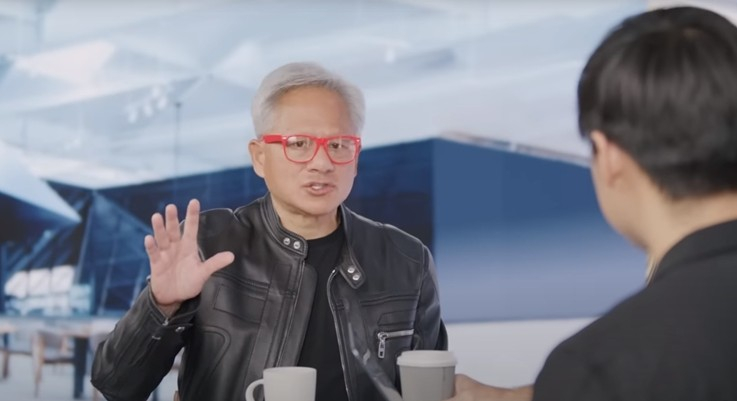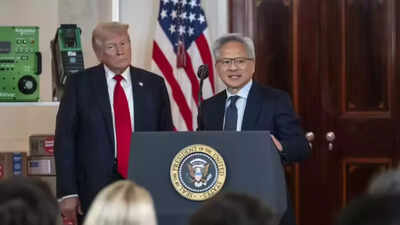Jensen Huang’s Insight on US-China Tech Competition - The Battle for AI Dominance
Nvidia CEO Jensen Huang stands at a critical juncture of one of the most consequential and complex technology rivalries in the world today—the ongoing competition between the United States and China in advanced semiconductor technologies and artificial intelligence (AI). As the leader of Nvidia, a company valued at over $4 trillion and a global pioneer in AI chips, Huang finds himself navigating not only commercial challenges but also geopolitical tensions that resonate far beyond the semiconductor industry.
This article provides a detailed, in-depth examination of Jensen Huang’s views, strategic actions, and the multifaceted implications of the US-China tech rivalry as it stands in 2025. It delves into Nvidia’s market role, Huang’s diplomatic initiatives, regulatory hurdles in China, economic impacts, and future prospects. All source links are embedded after each segment for transparency and reference.
Nvidia’s Pivotal Role in AI and Semiconductor Technology

Image Source: Reuters
Nvidia is at the heart of the global AI chipmarket. Its GPUs power the vast majority of artificial intelligence workloads worldwide, enabling machine learning, autonomous vehicles, data centers, and supercomputing applications. This market dominance translates into significant strategic importance, drawing attention from governments vigilant about maintaining their competitive edges in critical technologies.
China, which has invested heavily in AI and semiconductor development, remains a vital market for Nvidia. Yet, US export controls meant to constrain China’s military and technological advances have restricted the sale of Nvidia’s latest AI chips to Chinese customers. The restrictions target particularly high-performance products such as the H100 HBM3 GPU and its "watered-down" derivative, the H20, which was redesigned to comply with US regulations.
These controls have led to billions in lost revenue for Nvidia and supervisory challenges. Nvidia has had to continually adjust its product offerings and supply chain strategies to navigate a shifting regulatory and political landscape, illustrating the entwined nature of geopolitics and commercial technology today.
Sources: Times of India, Yahoo, Business Standard
Huang Advocates for Open Competition in the Chinese Market

Image Source: Global Times
Despite the increasing tensions, Jensen Huang emphasizes the benefits of open competition in China for both US companies and the Chinese market. He advocates allowing American technology firms to compete freely in China, to maximize the global impact of US technology and innovation.
On the BG2 podcast, Huang highlighted the narrow technological gap between US and Chinese semiconductor industries, describing China as "nanoseconds behind" in chip-making technology. This phrase underscores how close China is to catching up, but also the critical importance of continued competition to sustain US technological leadership.
Huang noted the strengths of China’s tech ecosystem, including an enormous talent pool, relentless work ethic, and vigorous intra-country competition. He insisted that these qualities, combined with access to global technologies, foster innovation that benefits both countries.
This stance is a strategic counterpoint to policies aimed at restricting Chinese access to American technologies, which Huang warns could accelerate Chinese self-sufficiency and reduce market opportunities for US companies. He argues that open engagement, rather than isolation, is the best pathway for sustaining innovation and economic growth on both sides.
Nvidia’s CEO as an Unofficial Diplomatic Actor

Image Source: Times of India
Beyond his corporate duties, Huang has played a crucial diplomatic role amid escalating US-China tensions. He has engaged with senior US and Chinese officials to negotiate terms under which Nvidia can continue exporting chips to China, positioning himself as an informal middleman in the trade war.
In mid-2025, Huang met with former President Donald Trump to secure a reversal of US export bans that had frozen shipments of Nvidia’s AI chips to China. The resulting compromise involved designing a compliant, lower-specification chip (the H20) for China and agreeing to a 15% levy payable to the US government on all sales there.
This arrangement enabled Nvidia to regain access to a critical revenue source, easing financial losses and stabilizing its supply chain. Huang’s role evidences how semiconductor technology executives increasingly operate at the intersection of commerce and international diplomacy, navigating complex national and global interests while advancing corporate goals.
He has also publicly acknowledged the broader political complexities, stating that the rivalry between the US and China involves "larger agendas" that transcend individual companies, emphasizing the thin line Nvidia walks between national security considerations and commercial expansion.
Sources: Aimagazine, Builtin,
Regulatory Challenges Within China

Image Source: CNBC
While Huang promotes open competition, Nvidia faces significant regulatory headwinds from Chinese authorities. The Chinese State Administration for Market Regulation (SAMR) initiated a preliminary probe into Nvidia's acquisition of Mellanox Technologies in 2019, focusing on potential anti-monopoly infractions.
This investigation reflects Beijing's intent to tighten control over foreign technology firms and protect the growth of domestic chipmakers. Nvidia has engaged actively with regulators, expressing readiness to comply with legal requirements, but the uncertainty around this probe presents hurdles to its operations in China.
Additional restrictions imposed by Beijing include blocking major Chinese tech companies such as ByteDance and Alibaba from procuring Nvidia's most advanced AI GPUs. These measures respond to China's strategic imperative to reduce reliance on foreign technology and accelerate indigenous chip development.
Such domestic regulatory pressures compound the challenges posed by US export controls, placing Nvidia in a complex operating environment that requires deft maneuvering to sustain growth in a key market.
Sources: Indianexpress, Scio.gov.cn,
The Broader Semiconductor and AI Chip Geopolitical Context

Image Source: Builtin
The US-China tech rivalry, particularly in semiconductors, has intensified amid broader trade wars and national security concerns. Since 2022, the US government has rolled out export restrictions that target China’s access to advanced semiconductor manufacturing equipment and critical chip technologies.
For Nvidia, these policies translate into complex licensing requirements and limitations on product sales. Alongside the revenue-sharing schemes, these controls aim to decelerate China’s semiconductor industry while bolstering US strategic advantages.
In response, China is investing billions to achieve chipmaking self-sufficiency, expanding support for domestic producers while encouraging alternative AI chip designs. The country's recent ban on certain Nvidia AI chips epitomizes a shift from limited dependence on US technology toward greater technological sovereignty.
Market reactions to these dynamics have been pronounced: China’s tech stocks surged on ripples of the Nvidia ban, signaling investor confidence in the country’s semiconductor aspirations.
The semiconductor competition is thus both a technological race and a trade conflict, with potentially enduring impacts on innovation, market segmentation, and global supply chains.
Sources: Business Standard, Aimagazine, Lapaas,
Financial Impact and Market Exposure for Nvidia
Image Source: Yahoo Finance
The export restrictions and Chinese market challenges have exacted a heavy toll on Nvidia’s bottom line. The company reported an $8 billion reduction in expected revenue in the quarter ending July 2025 due to curtailed shipments of the H20 chips in China.
China represents about one-eighth of Nvidia’s revenue. The H20 chip alone had contributed over $4.6 billion in first quarter sales prior to the imposition of restrictions. This exposure makes continued China sales critical for sustaining Nvidia’s growth trajectory.
To mitigate risks, Nvidia has continued to develop chip variants that abide by US export rules while serving Chinese customers. These product adjustments, combined with ongoing negotiations, are central to Nvidia’s strategy for preserving its position in the lucrative and rapidly growing Chinese AI market.
Investor focus remains sharp on Nvidia’s ability to manage geopolitical risks while capitalizing on the global AI surge, underscoring the challenges of balancing security and economics in a fractured geopolitical landscape.
Source: Reuters
Coexistence in Competition
Jensen Huang’s perspective and actions exemplify a pragmatic approach to a fractious global tech landscape shaped by rivalry yet interconnected by commerce and technology.
He argues for maintaining competitive but open markets to ensure the continued flow of ideas and investment between the US and China—a stance that acknowledges the globalized nature of innovation.
Key Nvidia Chips and Their Role in China Market Access (2025)
| Chip Model | Description | Export Status to China (2025) | Revenue Impact (Estimated) |
|---|---|---|---|
| H100 HBM3 | Nvidia's top-tier AI GPU for datacenters | Prohibited (US export controls) | High lost sales, >$4 billion annual |
| H20 (downgraded H100) | Compliant version tailored for China | Licensed for export under restrictions | Partial recovery of market share |
| RTX Pro 6000D | Workstation GPU used in AI and graphics | Banned in China (local regulatory moves) | Reduced sales, impacts professional markets |
| A100 | Prior generation AI GPU | Limited export, lesser revenue | Legacy sales continuing |
The semiconductor "nanoseconds" gap between the US and China indicates how pivotal near-term strategies are in determining future leadership. A bifurcated tech ecosystem risks slowing innovation and commercial gains for all parties.
Nvidia’s dual commercial and diplomatic roles illustrate a new model of tech leadership, where CEOs engage governments and global policy debates as intensively as product development and market strategy.
The tension between national security interests and commercial globalization will define the semiconductor sector’s trajectory and broader tech ecosystem evolution well into the coming decade.
This table captures the critical Nvidia AI chip models affected by regulations and the corresponding implications for access to China, Nvidia’s major growth market in the semiconductor space.







.png)







